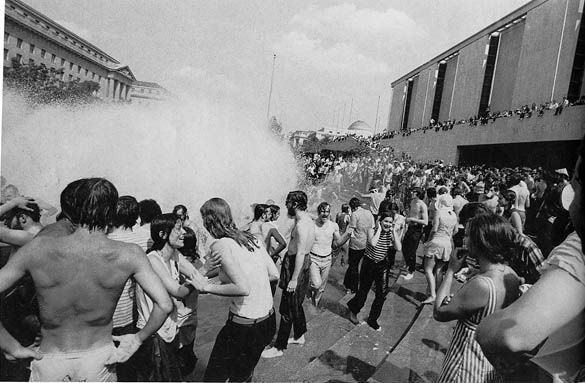(4PM EST – promoted by Nightprowlkitty)
Forty years ago today, 100,000 angry people descended on Washington for a mass march to end the war.
Preceding years had seen larger marches, to be sure, pushing toward a million strong on occasion, like April 1967 in NYC. But this one had been called only a week before, in response to the Cambodia invasion. Normally these exercises took months and months to pull together-getting the permits, choosing the slogans, printing the literature, spreading the word, renting the buses, mobilizing local groups to take part. And let’s not forget fighting over who should speak on the program.
I didn’t go to DC that Saturday. The NYU Uptown SDS chapter didn’t go, Nobody I was in touch with from the Washington Square Campus did either, if I recall correctly. Relatively few of the revolutionaries and other activists at the core of the campus upsurge on the East Coast did.
Partly, we had simply tired of Peace Crawls, as we had uncharitably taken to calling them. Starting in 1965, there had been two Big Marches a year, one in the spring and one in the fall, usually in either DC or NYC (and simultaneously in the Bay Area or L.A. or both). Sometimes, as with the March on the Pentagon, they marked a big step forward for the movement, usually because they took some unexpected action. More often they demonstrated that an awful lot of people wanted the war over with, most ricky-tick, and served as a reminder that it didn’t seem to be happening.
 >
>More particularly, we felt that it was a diversion right then. The unprecedented upsurge which we were in the midst of had been built on hundreds of campuses around the country and that was where the fight was going on. It would be pointless and potentially harmful to pullpeople away from those battlegrounds for a time-consuming roundtrip to a big city many hours or even days away.
In this case, there were countless discussions and debates in small groups, informal collectives, mass strike committees over what to do. Again, to belabor a point made earlier, there was no organized and recognized center to the movement. Had there been one, it might have put out a call that would have meant half a million plus in DC–or 25,000.
The powers that be were, it turns out, plenty scared of that Washington march. This was the stretch in which elements of the 82nd Airborne were moved into the basement of the executive office building and other potential occupation targets. I would still argue that throwing a scare into the bastards wasn’t enough to justify pulling forces away from the campus base areas that had been established. (After all, we had already frightened the shit out of them in November, 1969, when a 10,000 strong militant breakaway from the Big March had laid siege to the Justice Department, causing the Attorney General’s wife –Martha Mitchell, for those with long memories–who had been peering down from the top floor, to exclaim, “It looked like the Russian Revolution!”)
Meanwhile, the strike was about to win-or start folding up, depending on how you looked at it.
By that weekend, the outlines of the enemy’s overall strategy to deal with the flood of protest on the campuses was taking shape. University administrations around the country, a few at first, but with many more watching from the wings, started taking a stance of solidarity with the protesting students and faculty!
More specifically what they did was issue a proclamation with some variation of this message:
You splendid young people are correct. This crisis is no time for business as usual. We are therefore canceling all classes for the duration of the Spring semester. We urgently hope you will pursue the kind of change this country so obviously needs by, oh, for instance, going back to your hometowns to build opposition to the war and support for social justice.
Oh, yeah, no finals. Everybody gets a pass for all course work.
And the dorms are closing.
Mao Zedong’s famous dictum is that the guerrilla is like a fish swimming in the sea of the people. Well, for the activists, the campuses were our sea, and they were being drained a month ahead of schedule.
We had pulled it off. A national student strike, the dream of campus activists since the early ’60s, was shutting down the bulk of the American higher education system.
So what?
Now what?
Well, we still had the wind at our backs, and the coming weeks would see further gains won, but those two questions would loom larger as we kept building the struggle.

4 comments
Skip to comment form
Author
you about and a few more thoughts of my own.
The Farcebook set, content with first person shooter and not only dumbed down but compliance indoctrinated also. Happily lapping up diversions like ethnic foods and casual Fridays in leu of real raises, health insurance and other perks now long gone from the business world. It is a union of nothing with each seperate anti-war group tunnel visioning their own pet peeves about two illegal wars. All of them shun 911 truth.